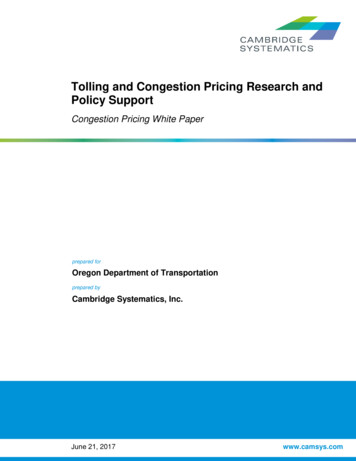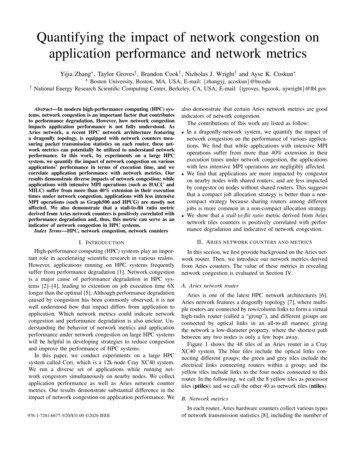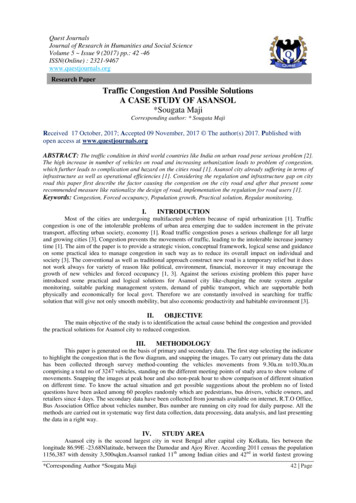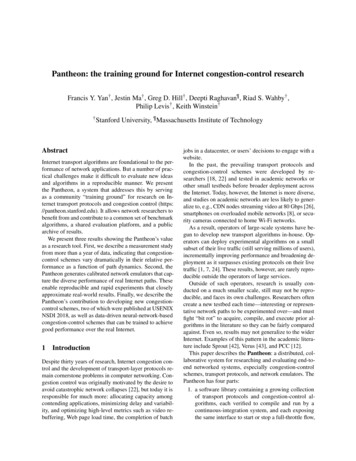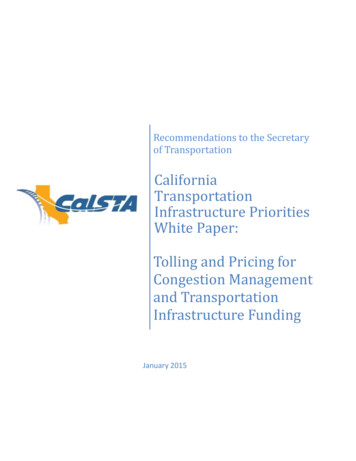
Transcription
Recommendations to the Secretaryof re PrioritiesWhite Paper:Tolling and Pricing forCongestion Managementand TransportationInfrastructure FundingJanuary 2015
Tolling and Pricing on State HighwaysThe California State Transportation Agency (CalSTA) established the California TransportationInfrastructure Priorities (CTIP) Workgroup in April 2013, to examine the current status of the state’stransportation system, discuss the challenges that lie ahead, andmake recommendations to the Secretary. The CTIP WorkgroupToll Bridges in Californiaincludes representatives from various state entities, but is primarilyRichmond-San Rafael Bridgecomposed of non-state entities, including but not limited to federal,Golden Gate Bridgeregional and local government representatives, labor and industrySan Francisco-Oakland Bay Bridgegroups, environmental and social equity groups. An InterimSan Mateo-Hayward BridgeRecommendation Report was issued in February 2014 and postedDumbarton Bridgeon the CalSTA website. The CTIP Workgroup continued to meet onCarquinez Bridgespecific topics in 2014 – one of these being the subject of tolling andBenicia-Martinez Bridgepricing. A CTIP subgroup on tolling and pricing met three timesAntioch Bridgeduring the spring and summer. A draft of this whitepaper waspresented to the entire CTIP Workgroup on September 16, 2014.Toll Roads in CaliforniaParticipants at that meeting were asked to vote in an anonymousState Route 73 (Orange County)text poll about support for the recommendation of this whitepaperState Route 125 (San Diego County)– of the participants voting, 38 people (or 89 percent) indicated theyState Route 133 (Orange County)“strongly agree” or “agree” with the recommendations, while 5State Route 241 (Orange County)people (or 11 percent) indicated they “disagree” with theState Route 261 (Orange County)recommendations. A list of attendees at the September meeting isattachment I of this whitepaper.Priced Managed Lanes in CaliforniaI-10 (Los Angeles County)Tolls are fees that drivers pay to use specific transportation facilities;I-15 (San Diego County)such has bridges, highways, or managed lanes. California has a totalState Route 91 (Orange County)of 152 centerline miles of toll bridges, toll roads, and pricedI-110 (Los Angeles County)managed lanes. These facilities are located in the San Francisco BayState Route 237 (Santa Clara County)Area, Los Angeles County, Orange County, and San Diego County.I-680 (Alameda and Santa ClaraCounties)Traditionally, tolling has been seen as a means to get new bridges,tunnels, and roads built by leveraging the revenue stream from tollsover many years. Many states have expressed a growing interest in tolling as the introduction of morefuel-efficient vehicles and inflation have reduced the amount and buying power of fuel tax revenues,which historically have represented their largest source of transportation funding. Tolling is also seen asa true “user fee” in that the toll revenues collected from system users are reinvested back into themaintenance and improvement of the system. Toll revenues can also be leveraged to provide financingfor other transportation improvements.Tolling, in the form of pricing, is increasingly being used as a means to help improve mobility. Pricingfocuses on the use of tolls to manage traffic demand, by varying the toll charged based upon the time ofday, day of week, and/or real-time traffic conditions. Revenue generation is a secondary objective onpriced facilities. Pricing can be applied to traditional toll roads, bridges, tunnels, or managed lanes. Themajority of priced facilities in California are managed lanes, either in the form of high occupancy/toll(HOT) lanes or express toll lanes; the term “express lanes” is often used when referring to priced1
managed lanes. The majority of tolled projects proposed on the State Highway System will be expresslanes with the objective of mobility management.1 Background on Tolling and Pricing in CaliforniaCalifornia has long used tolling, albeit in a very limited way, to help pay for transportation infrastructure.For much of the 20th century, the focus was to charge tolls to finance large transportation projects,specifically bridges. The State built 9 toll bridges in the San Francisco Bay Area, Los Angeles, and SanDiego, and a separate bridge district comprised of several counties built and continues to operate theGolden Gate Bridge.In 1987, two joint powers authorities were authorized to charge tolls as well as development fees tofinance a 67-mile network of highways in Orange County. This was followed two years later by theState’s first public-private partnership (P3) law in 1989, which authorized Caltrans to establish franchiseagreements with private entities for up to four transportation facilities and mandated the use of tolls tohelp finance the projects. Two projects were built using this P3 provision. One of these projects, theState Route 91 Express Lanes, was the first priced managed lane facility in California, where acombination of tolling, access control, and vehicle occupancy were used in order to ensure that thefacility operated at a high level of performance.In 1993, Assembly Bill 713 was passed, implementing priced managed lanes on Interstate 15 in SanDiego County. For this particular project, the San Diego Association of Governments (SANDAB) wasgiven authority to convert existing high-occupancy vehicle (HOV) lanes to HOT lanes. The success of thisproject led to subsequent legislation (Assembly Bill 2032) in 2003 that authorized SANDAG and otherregional transportation agencies to operate additional HOT lane projects in San Diego County as well asin Alameda and Santa Clara Counties. This was later followed by legislation in 2006 (Assembly Bill 1467)that allowed regional transportation agencies to request approval from the California TransportationCommission (CTC) to operate HOT lanes. The number of projects was limited to four - two in northernCalifornia and two in southern California. Projects were authorized in Los Angeles and RiversideCounties and the San Francisco Bay Area under this provision, which expired in 2012.A new statute (Senate Bill X2 4) authorizing P3 projects became law in 2009. Under this statute, regionaltransportation agencies or Caltrans could enter into P3 agreements for projects, and tolling is an optionto provide a source of financing for the projects. This law will sunset in 2017. In 2010, Assembly Bill 798became law, establishing the California Transportation Finance Authority (CTFA). CTFA was granted thepower to authorize Caltrans or other regional transportation agencies to use tolls as a means offinancing a transportation facility. This authority through the CTFA has no sunset date.2 Typical Uses of Toll RevenueHistorically, the primary intent of tolling has been for project financing, as seen with the 9 State-ownedtoll bridges, the Golden Gate Bridge, and the Orange County toll road system. Tolls collected on theState-owned bridges cover the costs of replacing or retrofitting bridges for seismic safety, and expandingbridges to handle increased traffic (tolls were removed from the bridges in southern California once thefacilities were paid for and their seismic safety retrofits were completed). Facilities funded using a P3may use tolling to help recoup project development costs, and toll revenues on projects authorized byCTFA are to be used to pay for the project development costs.2
State law initially required that tolls be removed from the State-owned toll bridges once the revenuebonds used to finance the facilities were paid off but this requirement was removed in 1972, and tollsare now used to cover the costs of operating and maintaining the facilities as well as pay off projectindebtedness. Toll revenues from P3 projects or projects authorized by CTFA may also be used to coverthe costs of operating and maintaining the facility.Tolls collected on the Golden Gate Bridge are used to cover operations and maintenance costs on thatfacility. The bridge district has also authorized to use tolls to subsidize transit service and ferry service.In addition, voters in the San Francisco Bay Area have twice approved specific bridge toll increases onother toll bridges to finance freeway and transit improvements in the region and to cover the costs ofoperating transit service. The most recent measure (Regional Measure 2) is expected to provide over 3billion in toll revenues through the year 2040 to cover highway and transit improvements and subsidizetransit operations in the region. By statute, transit operation subsidies may account for up to 38 percentof annual expenditures of toll revenue.Revenues from express lanes are used to cover thecapital, operations, and maintenance costs of the91 Express Lane Toll Revenue Generationlanes. Although the intent of tolling with express(2013)lanes is to manage demand on the facilities, thereGross Revenues 39.3 millionis the possibility that additional revenue could beOperating Expenses 17 milliongenerated above and beyond what is needed forNet Revenue 22.3 millionthese expenditures. In that case, the remainingrevenues are to be used to fund projects andservices that provide congestion relief on the same freeway corridor. The express lanes on State Route91 generated 22.3 million in net revenues in 2013. In San Diego, the express lanes on I-15 wereexpected to generate over 5 million in toll revenue in fiscal year 2014. Approximately 18 percent ofthose revenues were dedicated to financing transit service in the I-15 corridor.The use of tolling and pricing has been increasingly supported by the federal government as a means toincrease capacity and manage existing capacity. Since 2005, federal law has allowed states to convertHOV lanes to HOT lanes without federal approval. The Moving Ahead for Progress in the 21st CenturyAct (MAP-21), which took effect in October 2012, further streamlined the use of tolling by eliminatingfederal approval and tolling agreement requirements to toll new capacity on existing freeways. Federallaw also requires toll revenues to be used first to cover the costs of developing, operating, andmaintaining the facility, and providing a return on investment to any private investment partner. Excessrevenues may be used for any transportation purpose within the subject corridor for which Federalfunds would normally be used.3 Recommendations from the Tolling and Pricing SubgroupThe California State Transportation Agency and the CTIP Workgroup have convened to discuss policiesand issues related to developing a tolling and pricing policy for state highways. Through these efforts,the CTIP workgroup recommends moving forward on a clear policy that would clarify the process fordetermining use of toll revenues, and streamlining the statutory process to use tolling and pricing whereappropriate. The following are suggested recommendations from the Tolling and Pricing subgroup:3
3.1 Policy on Tolling and Pricing Related to Congestion Management and FundingTransportation InfrastructureCalSTA or Caltrans should issue a high-level policy that provides general guidelines on the use of tollingon the State Highway System (SHS). The policy should state that Caltrans will support the use of tollingon the SHS, where appropriate, to optimize system performance and provide an alternative source oftransportation funding to maintain and improve infrastructure. It is expected that tolling will be used inmost cases as a system performance management strategy. Existing toll facilities and approved projectswould not be subject any of the terms and conditions of the policy that would conflict with statute,existing financial commitments, existing policies on revenue usage, or voter commitments. Caltrans or aregional transportation agency should have the authority to collect tolls.The policy would require that tolling be considered during the planning and development of capacityimprovements on the SHS as a means of managing demand, financing the improvements, or both.Tolling would only be applied on new SHS facilities, new capacity added to existing SHS facilities, andexisting high-occupancy vehicle lanes. State and Federal laws currently prohibit conversion of non-tolledlanes to tolled lanes, with the exception of existing HOV lanes. Congestion pricing and all-electronictolling would be required for priced managed lanes and would need to be considered for other tollfacilities where feasible. Incentives such as discounted tolls or toll-free passage could be granted tohigh-occupancy vehicles, transit vehicles, and zero- and low-emission vehicles, as appropriate.The policy would require that whenever tolls are implemented on the SHS, Caltrans and regionaltransportation agencies would sign agreements that define overall roles, responsibilities andrequirements related to maintenance, operations, data sharing, performance monitoring, and annualaudits and reports. Regional transportation agencies that sponsor projects would be required toreimburse Caltrans for costs incurred relative to the development, operation, and maintenance of thefacility as part of these agreements.Toll revenues would be used first be used for direct expenses of the toll facility, including: Debt service, if any. Administration. Operations and maintenance. Capital improvements. Appropriate reserves for the above items. Reimbursement to the California Highway Patrol for enforcement services.Unless otherwise specified by project financing requirements, excess toll revenues, if any, would need tobe used for projects that improve travel reliability, provide travel options, or improve the safety andoperations of the transportation corridor in which the tolls were collected. These improvements couldinclude, but not be limited to: Transit service Active transportation projects. Operational improvements. Augmentation to existing maintenance and operation expenses on adjacent lanes.An expenditure plan for the use of excess revenues would be developed collaboratively by projectstakeholders on an annual basis. The plan and each annual update would be made available for public4
review and comment for not less than 30 days prior to adoption by the governing board of the projectoperator. For projects operated by the department, the plan shall be adopted by the commission. Theplan would take into account the financial contributions and roles and responsibilities of all projectstakeholders.3.2 Policy on Managed LanesIt is expected that the majority of new toll facilities in California will be priced managed lanes. Inanticipation of this, Caltrans has been in the process of updating its existing policy on HOV lanes on theSHS to address HOV lanes as well as express lanes. The policy has been vetted with regionalstakeholders and should be finalized to reflect the comments received from stakeholders and therequirements of the statewide tolling policy.The policy would state that Caltrans supports the use of managed lanes on the SHS as a sustainabletransportation system management solution. Managed lanes will be used to promote carpooling andtransit ridership, improve travel time reliability, reduce greenhouse gas emissions, and maximize theefficiency of the freeway system by increasing person and vehicle throughput while reducing congestionand delay. Caltrans will partner with regional transportation agencies to develop plans for managedlanes on the SHS in each of the State’s large urban areas.The policy would identify the types of operational strategies used on managed lanes, including pricing.Caltrans or a regional transportation agency could have the authority to collect tolls on priced managedlanes. Operational strategies (and any changes in those strategies) for managed lanes would bedetermined by Caltrans in cooperation with regional transportation agencies and the California HighwayPatrol, and in consultation with other affected stakeholders. Operational strategies would bedetermined based on factors such as safety and mobility considerations, regional consistency, trafficforecasts, life cycle costs, revenue potential, enforcement needs, environmental considerations, andcommunity support.The use of toll revenues from managed lanes would be addressed under the statewide tolling policy.3.3 Legislation to Expand the Use of Tolling and Pricing in CaliforniaThere is currently very limited authority for Caltrans and regional transportation agencies to collect tollson the SHS. The current processes utilizing a P3 or CTFA have not always been practical for projectsponsors to utilize. Not all projects may be suitable for a P3. The CTFA process focuses primarily on theuse of tolling for project funding and not so much as a mobility management strategy. Because of theseconstraints, the CTIP Workgroup recommends that additional tolling authority should be developedthrough legislation that would enable tolling to be used for either mobility management or projectfinancing. The proposed legislation would permanently reinstate the process established underAssembly Bill 1467 in 2006, in which regional agencies could apply to the CTC to operate HOT lanes. Theproposed legislation would expand this authority to Caltrans, eliminate the cap on the number ofprojects that could be approved, and would also include express toll lanes and toll roads in addition toHOT lanes. Provisions of the legislation would be as follows: Caltrans and regional transportation agencies could seek authority from the CTC to operate a tollfacility.5
The California Transportation Commission would approve the projects, based on eligibility criteriaestablished by the Commission; these criteria would most likely be similar to the criteria developedfor the process established in Assembly Bill 1467.Toll revenues would need to be used for direct expenses related to the development, maintenance,administration, and operation, including collection and enforcement, of the facilities, and reservesfor these purposes.Any remaining revenue would be used for projects that improve travel reliability, provide traveloptions, or improve the safety and operations of the State highway corridor in which the tolls werecollected. An expenditure plan for the use of excess toll revenues, if any, shall be developed by thedepartment and the regional transportation agency and updated annually. The plan and eachannual update would be made available for public review and comment prior to adoption by thegoverning board of the project operator. For projects operated by the department, the plan shall beadopted by the commission.Regional transportation agencies would have the ability to issue toll revenue bonds to financeprojects. The State Treasurer would be given the authority to issue toll revenue bonds for projectsthat would be operated by the State.A regional transportation agency would be defined as a regional transportation planning agency, acounty transportation commission, any other local or regional transportation entity that isdesignated by statute as a regional transportation agency, or a joint exercise of powers authority.4 DefinitionsBelow are definitions for several terms used throughout this white paper.Tolling: Charging a price to motorists to use a transportation facility, such as a bridge, tunnel, or road.Revenues are typically used to pay for the costs of building, operating and maintaining the facility.Pricing: Tolls that vary based on the level of vehicle demand on a highway facility. Tolls may vary by timeof day (static) or according to real-time conditions on the facility. Also known as congestion pricing,value pricing, or variable pricing.Managed Lanes: A set of exclusive or preferential use lanes on a freeway that are proactively managedin response to changing conditions using strategies such as access control, vehicle eligibility, pricing, or acombination thereof.High Occupancy Vehicle (HOV) Lane: A type of managed lane that may be used by vehicles carrying aminimum number of occupants.High Occupancy/Toll (HOT) Lane: An HOV lane that lower occupancy vehicles may access by paying atoll.Express Toll Lane: A managed lane on which all users pay a toll; vehicles carrying a minimum number ofoccupants may pay a discounted toll to use the lane.Express Lanes: A blanket term for HOT lanes or express toll lanes.6
Electronic Toll Collection (ETC): A method of collecting tolls using a transponder (associated with apre-paid account) mounted in a vehicle and overhead antennas that read the transponder. An ETCsystem may utilize an automated license plate reader to assist in identifying vehicles not equipped with atransponder.All-Electronic Tolling: The collection of tolls on toll facilities using only ETC. Also known as cashlesstolling.Regional Transportation Agency: A regional transportation planning agency, a county transportationcommission, any other local or regional transportation entity that is designated by statute as a regionaltransportation agency, or a joint exercise of powers authority.7
Attachment IParticipants in September CTIP MeetingFirst lMarkSharonJanetJoshJoeChrisLast alifornia Bicycle CoalitionCalifornia Air Resources BoardCalifornia Department of FinanceCalifornia Department of FinanceCalifornia Department of TransportationProfessional Engineers in California GovernmentCalifornia Department of FinanceCalifornia Department of FinanceCalifornia Department of FinanceSenate President Pro Tempore OfficeOffice of Assembly Speaker Toni AtkinsSan Diego Association of GovernmentsMetropolitan Transportation CommissionMetropolitan Transportation AuthorityMetropolitan Transportation AuthoritySacramento Area Council of GovernmentsCalifornia Department of TransportationCalifornia Department of TransportationCalifornia Department of TransportationCalifornia Department of TransportationCalifornia Department of TransportationRiverside County Transportation CommissionSonoma County Transportation AuthorityProfessional Engineers in California GovernmentLeague of California CitiesSouthern California Association of GovernmentsCalifornia State Transportation AgencyAuto Club of Southern CaliforniaOrange County Transportation AuthorityTransportation CaliforniaEl Dorado County Transportation CommissionAssembly Transportation CommitteeTransFormCalifornia Department of TransportationCalifornia Trucking Association8
insMcKeeverKellyAnnisGreerCalifornia Transportation CommissionMetropolitan Transportation CommissionCalifornia State Association of CountiesFresno Council of GovernmentsNatural Resources Defense CouncilMetropolitan Transportation CommissionCal WalksCalifornia Construction and Industrial Materials AssociationConsultant at California State SenateCalifornia Transit AssociationCalifornia Department of TransportationFederal Highway AdministrationFederal Highway AdministrationBay Area CouncilCalifornia Alliance for JobsFederal Rail AssociationSan Joaquin Regional Rail CommissionCalifornia State Transportation AgencyCalifornia State Transportation AgencyCalifornia State Transportation AgencyCalifornia Association of Councils of GovernmentSacramento Area Council of GovernmentsCalifornia State Transportation AgencyCalifornia State Transportation AgencySouthern California Leadership Council9
Historically, the primary intent of tolling has been for project financing, as seen with the 9 State-owned toll bridges, the Golden Gate Bridge, and the Orange County toll road system. Tolls collected on the State-owned bridges cover the costs of replacing or retrofitting bridges for seismic safety, and expanding
